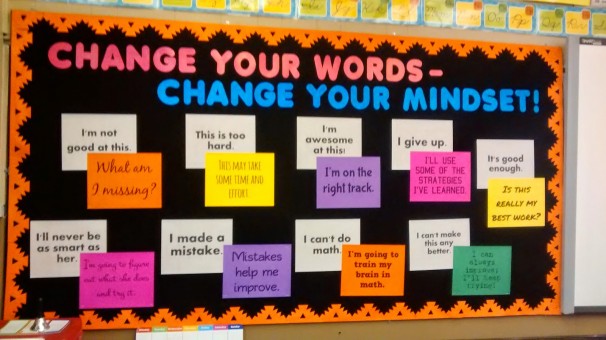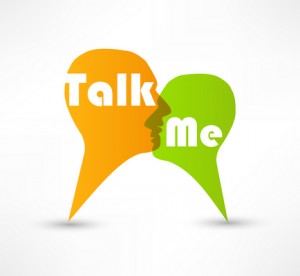Our Words Determine Our Co-teaching Mindset
A MiddleWeb Blog

There’s also a lot of chatter in the hallways of schools where educators are creating bulletin boards to remind all learners to WAKE UP and listen to the meaning of our words. I even found this blog post that provides the how-to (with downloads!) for educators interested in creating a mindset-changing bulletin board of their own.
Educators are becoming more aware how to shape our learning environment with students, not only through colorful and potentially powerful visuals – but also through our decisions as we choose the language we think and speak. Yes, our thoughts are THAT powerful!
Our internal dialogue can be considered our driving force in creating our experiences. The more positive our thoughts, the better chance we will create successful pathways to achieve whatever it is we are aiming to accomplish.
Educators are embracing the process of growth mindset as a way to teach not only our content areas but also the very individuals in our classroom. We are connecting with the human side of teaching. For example, educators are supporting the power of “Yet” to guide our students (as well as ourselves) to shape our attitude and our actions.

Quick “Changing Words, Changing Mindset” Refresher
The idea is to change our thoughts and spoken language to create a positive view about learning as a process. Our thoughts and spoken language can jumpstart positive outcomes.
Here are some examples:
I am not good at this TO I will keep practicing and working at doing my best.
I made a mistake, I give up TO I am learning from my mistakes and improving
I am just not good at math TO I can always improve – I will keep working.
Guiding learners to embrace a positive mindset can place them firmly within the awareness that all learning is a process and that it starts with the way we THINK about ourselves as learners.
It doesn’t take much effort to see where I’m going with this. It is just THAT easy to apply to our co-teaching world. Let me put it in neon lights here…
Change Your Words – Change Your Co-Teaching Experiences

There are a few communication categories that just scream “watch your thoughts” because they create your spoken language and your actions. Let’s consider how to make the most of our co-teaching language.
► Co-teaching relationship: First and foremost change from “I” to “we” and from “my” and “your” to “our” to send the right messages that you share all responsibilities. All students are your shared students – even as both teachers impart a unique area of expertise for each student.
► Co-Planning: Get rid of language that tells the other teacher what you’re doing and create an open dialogue to listen and share instructional ideas.
For example:
Change from Here’s what we’re doing today TO Here are my ideas for our lessons next week. What do you think?
► Instructional Process: Move away from one teacher as sage on stage or leader of the lesson and embrace a process of a cohesive shared vision and action plan.
For example:
• Change from She let me teach the social studies lesson TO We each have a role in the instructional process. Let’s work off of one another’s strengths.
• Change from I will teach and you can walk around and help students as they need TO What co-teaching models would amplify the learning for everyone?
• Change from I want my students to listen to what I have to say TO How can we apply our individual teaching styles to raise student voice and deepen learning for everyone?

For example:
Change from We don’t have time for that because we must teach this lesson TO How can we weave in these strategies as we share the content?
► Assessment: Remember to include assessment as a part of the instructional process to foster self-regulated and self-motivated learners. Get away from grading everything. Put the focus on learning as a process, not as an end result or grade that you gave students.
For example:
Change from I’m giving them a test on Friday so we know what they learned TO How can we use class activities to guide each student to take charge of his or her learning? What methods can we use to monitor students’ learning?
From Thoughts to Actions
The importance of communication with our co-teachers is not news to anyone. But we must remember to reflect on the source of our co-teaching language – our own thoughts! Hopefully this post serves as a reminder that our thoughts and words lead to our actions and conversations. As we continue to shape our co-teaching mindsets, just think about the vast learning opportunities for all involved. And once we have a clear understanding of our own perspective, we can then open our minds to learning and teaching alongside our colleagues.
What is one experience you have when thinking about your co-teaching mindset? What is one way you will change your co-teaching mindset?
_____________
Cover image: Sarah Hagan, Hello My Name is Sarah and I Believe Math = Love































Wow as a graduate student and new to teaching; I am glad that my professor had this as part of his lesson to all of us new special education teachers.
There needs to be more training on co-teaching, especially for new teachers who are often given co-teachers. If I had more training my first year of teaching on this topic it would not have been such a disaster.